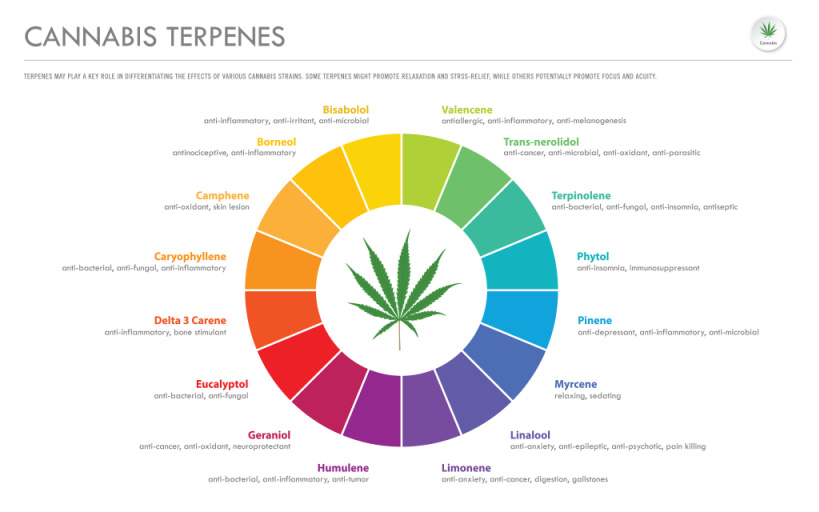The citrus of an orange rind. The smell of lavender as the wind stirs it in its fields.
The aromatic moments that we’ve grown to love in the world around us are largely derived from compounds known as terpenes. Terpenes give not just plants their famous scents and flavors, but also cannabis.
An introduction into the world of cannabis requires, at a very basic level, an understanding of terpenes. Terpene profiles differentiate one strain from the next, offering expanded experiences based upon the needs of the consumer or the goals of the grower.
Today, we are going to explore the world of terpenes, what they do, and how to inspire further production in your cannabis garden at home.
So, What ARE Terpenes?
Put plainly, terpenes are extremely aromatic compounds that offer the smells we associate with plants, herbs, and animals. Terpenes are often isolated and used to flavor and scent many products in our day-to-day life, including bath products and perfumes.
In nature, terpenes are vital in playing a protective role in the life of the plant, healing and protecting the plant from potential danger. Terpenes also act on behalf of the plant’s immune system, often preventing infectious germs from taking hold.
Improving Terpene Production in Cannabis
Terpenes are a natural compound in the world and they are particularly important to the development of high-quality cannabis. Terpenes work directly alongside other cannabinoids, including THC and CBD, to provide a fully-fledged and well-rounded experience for consumers.
Let’s explore a few different ways that growers can make sure they are developing terpene-rich cannabis by making small adjustments to their methods.
Amend Your Soil With Nutrients
If you want to enjoy the cultivation of large, compact, and stinky buds then you will have to learn to embrace sugars and carbohydrates. Carbs primarily operate as the primary source of energy for your cannabis plants, offering energy in lockstep with sugar to contribute to the structure of the plants.
Creating a rock-solid nutrient schedule that promotes a full feeding of sugar can bring about the development of a richer and more complex terpene profile. Sugar carbs are especially important as the plant enters its flowering stage, where these terpenes are most notable in their effect.
Focus on High-Quality Genetics
At the end of the day, much of the terpene development that goes on in your cannabis plant will rely on the genetic code within. High-quality genetics can result in better-quality products, so make sure that you are acquiring your seeds or clones from a reputable source. Some strains are simply predisposed to certain effects. Even the best grower in the world cannot make bagseed look like White Widow!
Optimize Your Growing Environment
Light and nutrition are the core factors that coincide with a successful cannabis harvest. If you are looking to successfully grow your cannabis with terpene-rich cannabinoids, you’ll want to offer exceptional light coverage.
Indoor growers must make sure to carefully cover the entirety of their plants, ensuring that no coverage is lost at the lower levels of their cannabis. Make sure that there is space between your plants for colas to acquire the same amount of sunlight as everywhere else.
Outdoor growers get to enjoy the natural benefits of excess outdoor lighting, bringing flavorful results that are also aromatic. The natural light of the sun offers a full and complex spectrum to feed your plants.
Embrace Low-Stress Training
Trichome and terpene development is often tied to the defense mechanisms of the plant itself, largely against pests and herbivores. Slightly stressing your plants to engage their defense mechanisms is known as Low-Stress Training. Low-stress training is an ideal way to induce minor levels of stress that can dramatically increase your terpene production.
Begin LST as early as possible, ideally after your plant is in a comfortable vegetative state. Allow the plant to establish a few nodes before beginning the process. Tie down and prune lower branches to help redirect energy to other flowers, causing trichome production to explode.
Some growers will turn off their lights for 48 hours before the date of harvest to trick the plants into thinking that they are dying. This causes the plants to release the resin in their systems, pushing the sticky production toward those fully-formed buds.
Low-stress training can be a fantastic way to induce better tasting, smelling, and smoking of cannabis. Make sure that you carefully monitor your garden during this process to prevent any missteps from occurring.
Don’t Forget to Flush Your Plants
Roughly two weeks before harvest, you should put an end to feeding your plants. This is known as flushing and it is a way to make sure that you have no toxic nutrient build-up when it comes time to harvest. Flushing the plant will reveal the natural and more robust flavors and aromas hidden behind your feeding schedule.
Utilizing a pure water source for the final two weeks of the harvest will allow your plant to slowly wash away the nutrients that you’ve fed it with over the prior weeks, leaving you with something clean, fragrant, and potent.
A proper flush is necessary to maximize terpenes as well as their impact on the final product.
Improve Your Grow and Embrace Terpene Production
Developing robust harvests with terpene-rich cannabis requires attention to detail and the willingness to implement a few of our key tips. Prioritize high-quality genetics, maximize light coverage, and embrace low-stress training to make sure that your plants are as exceptional as they can become!


















